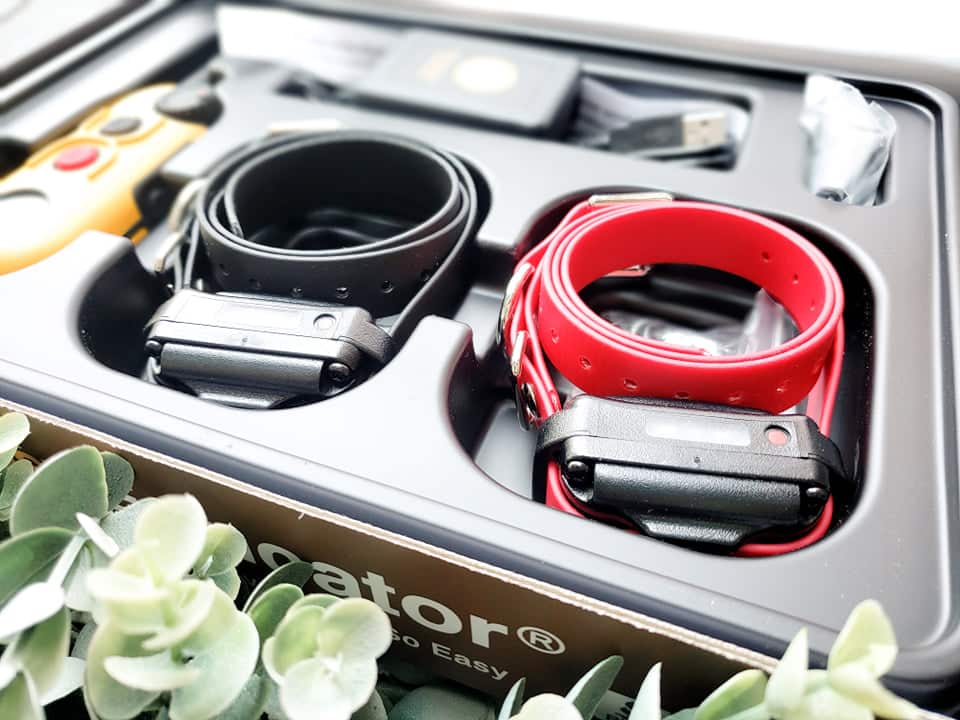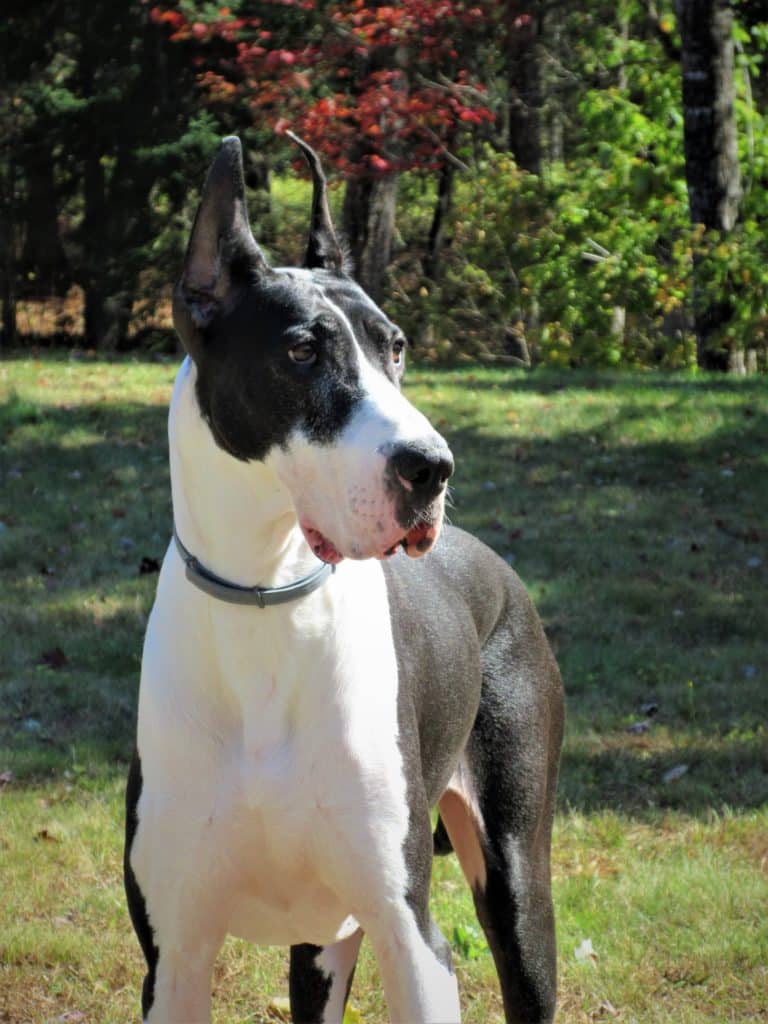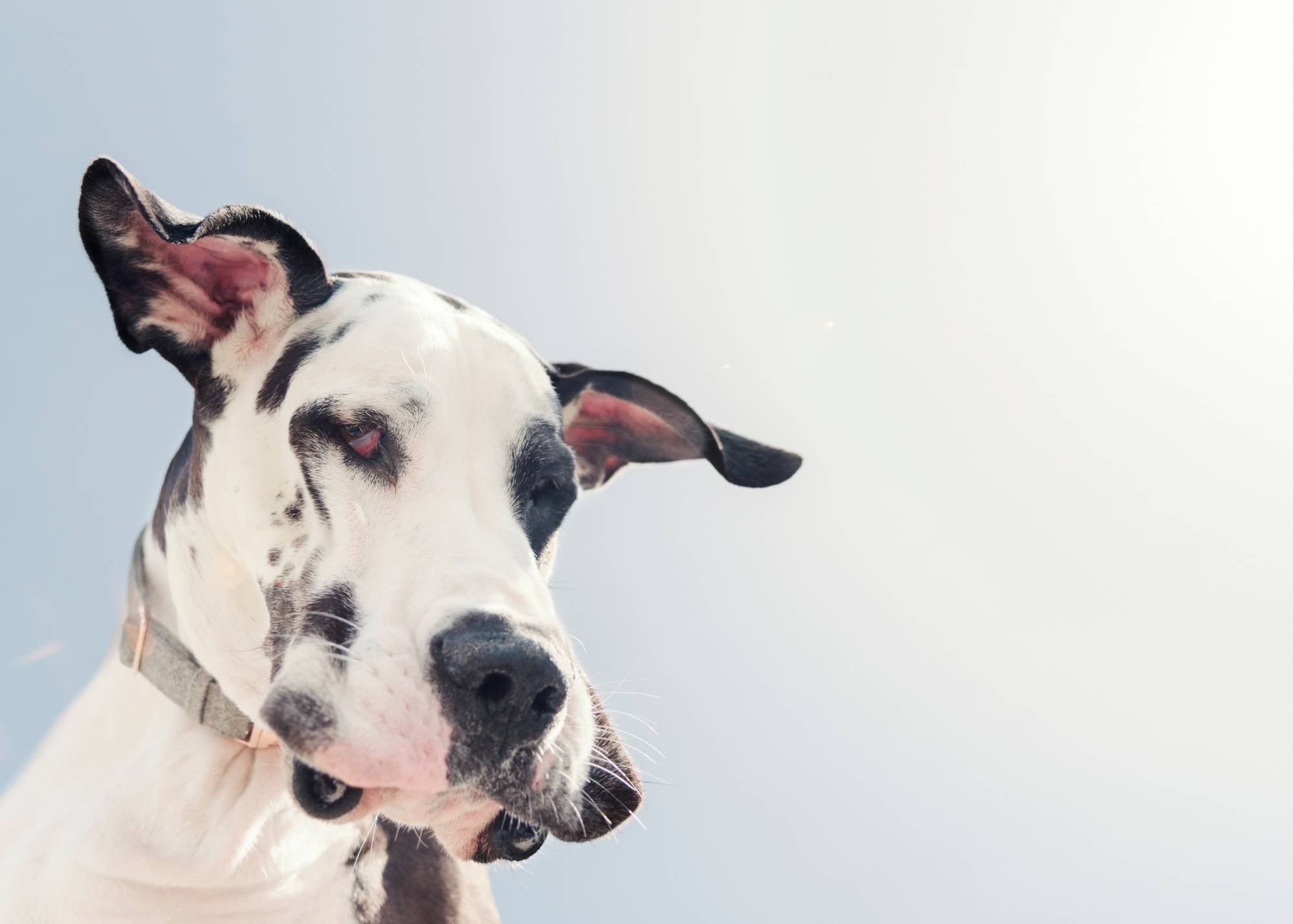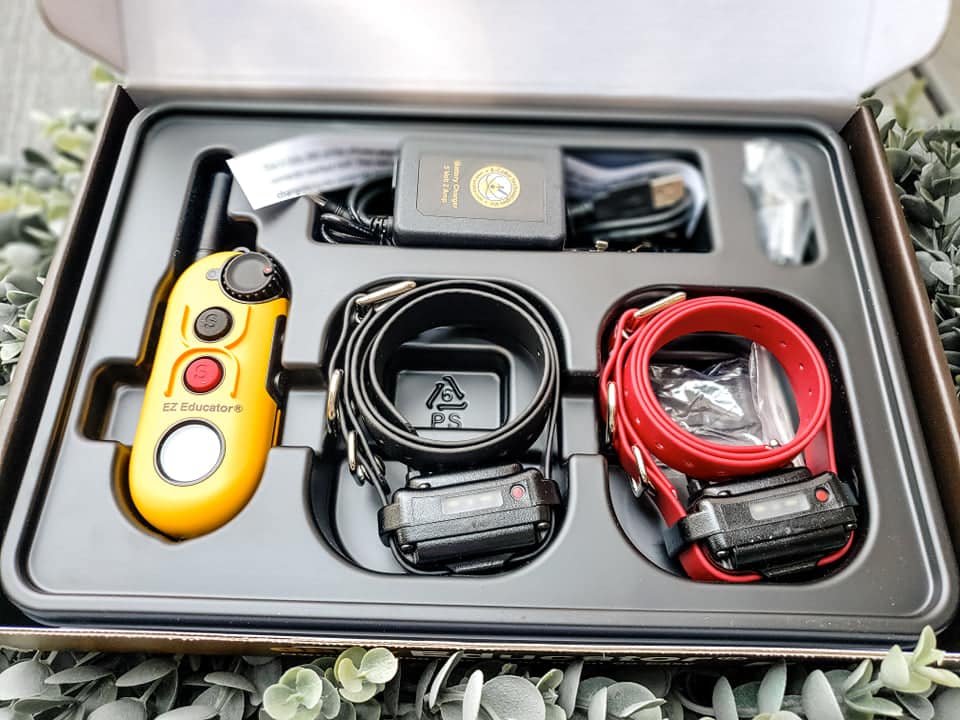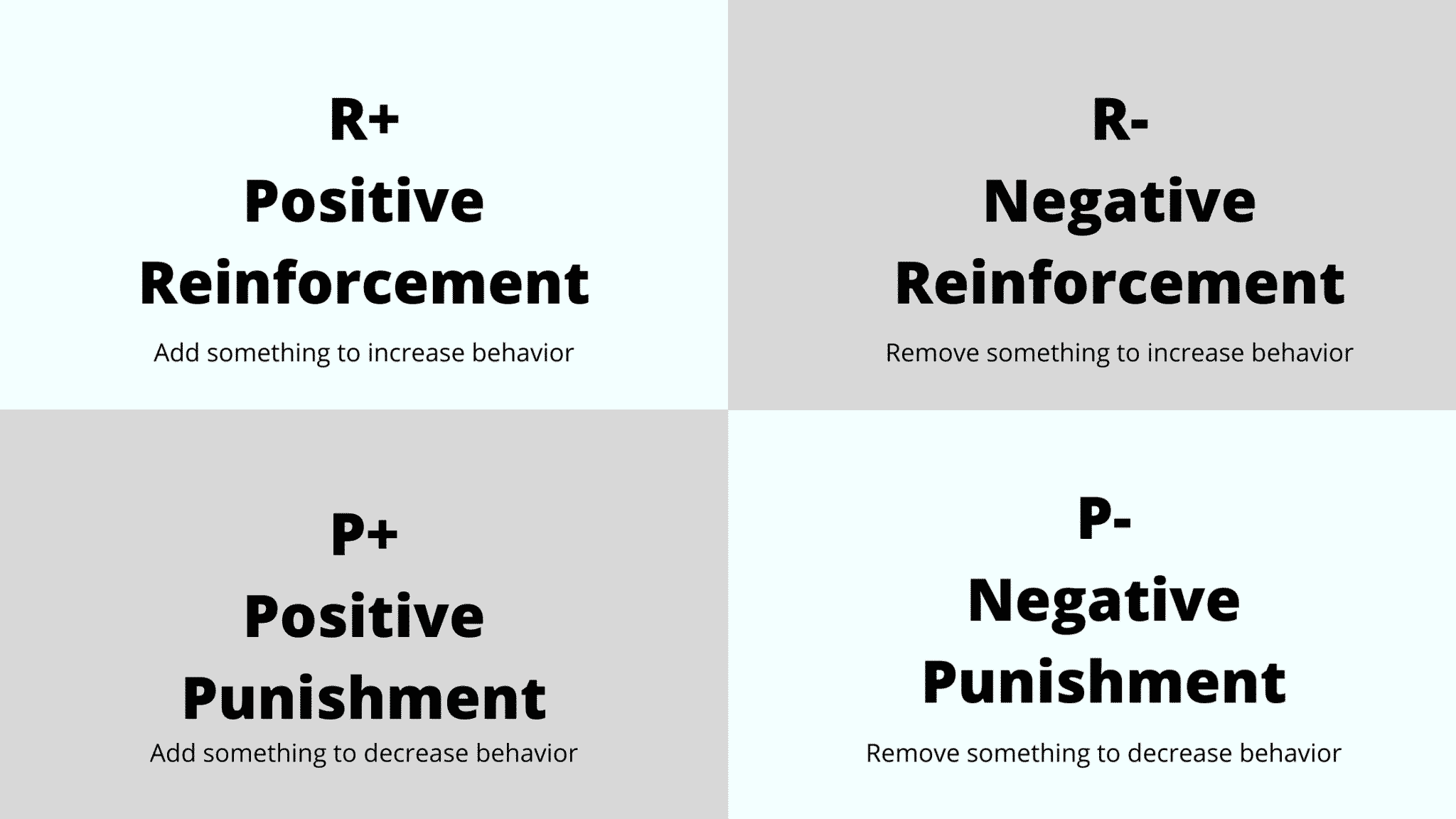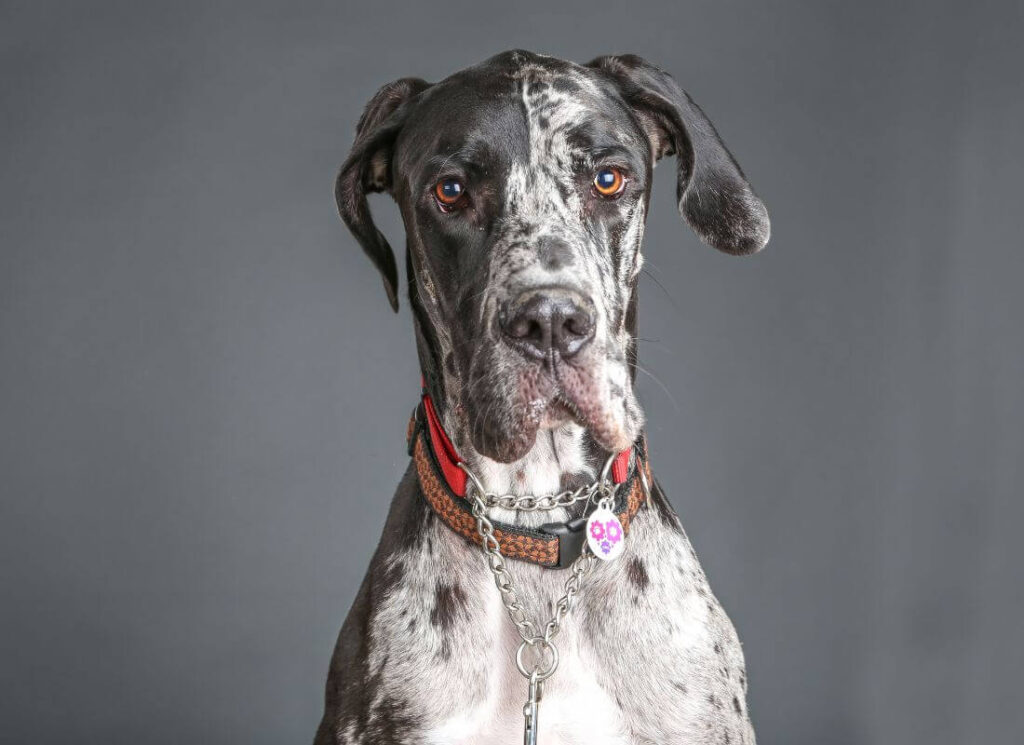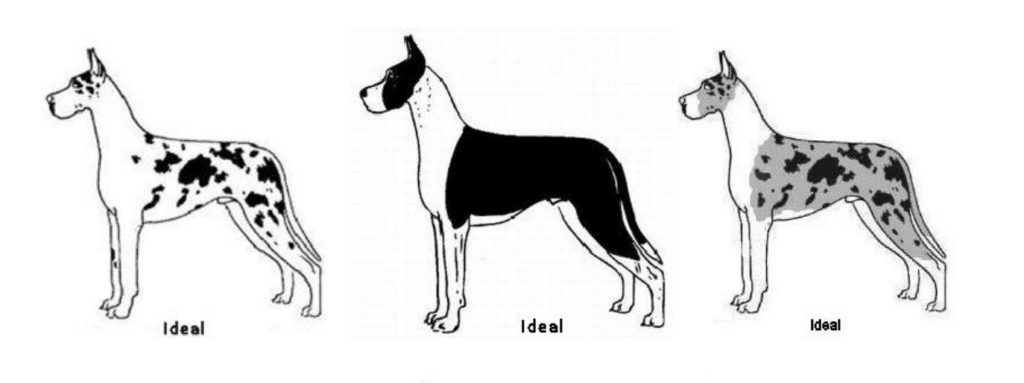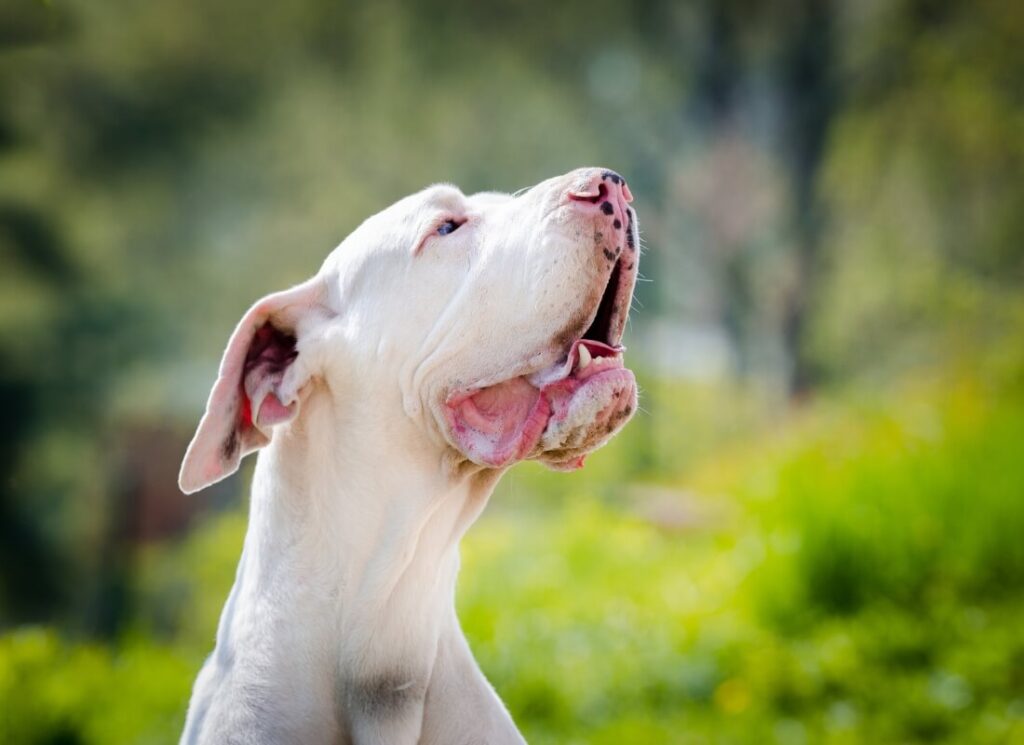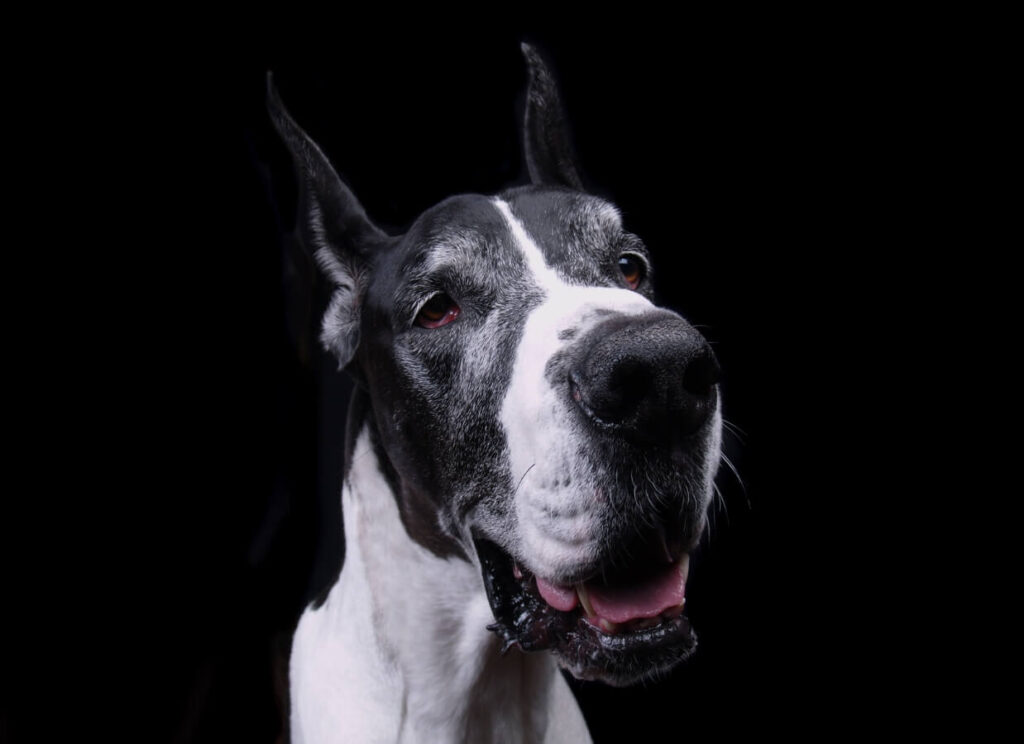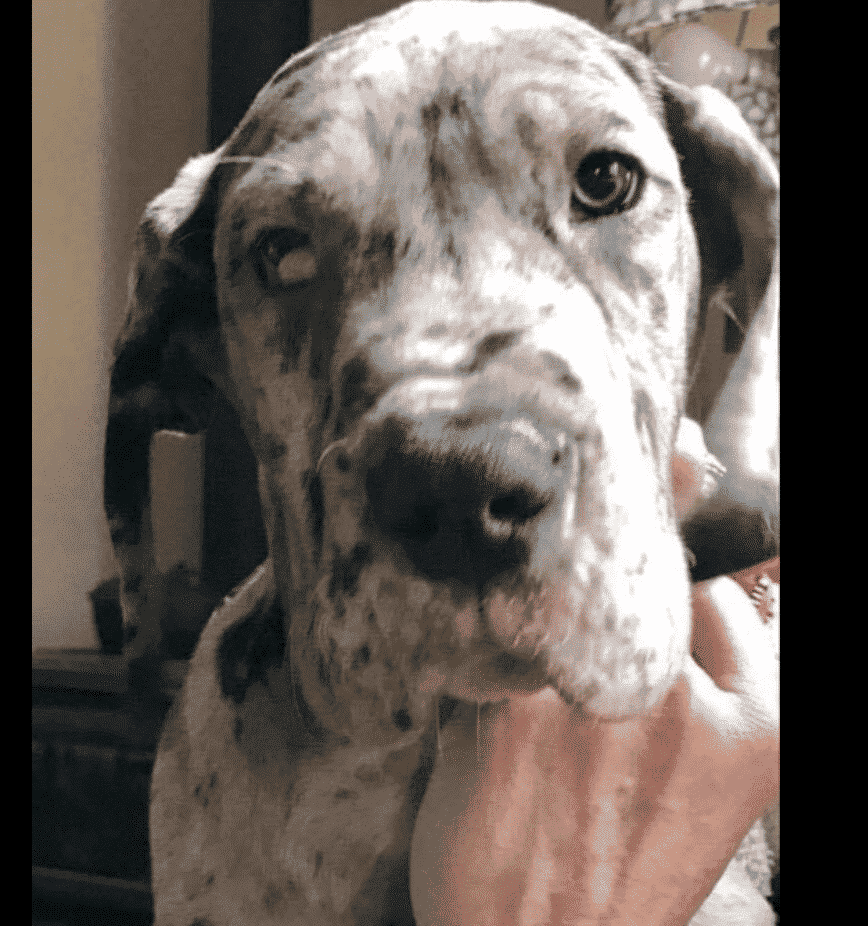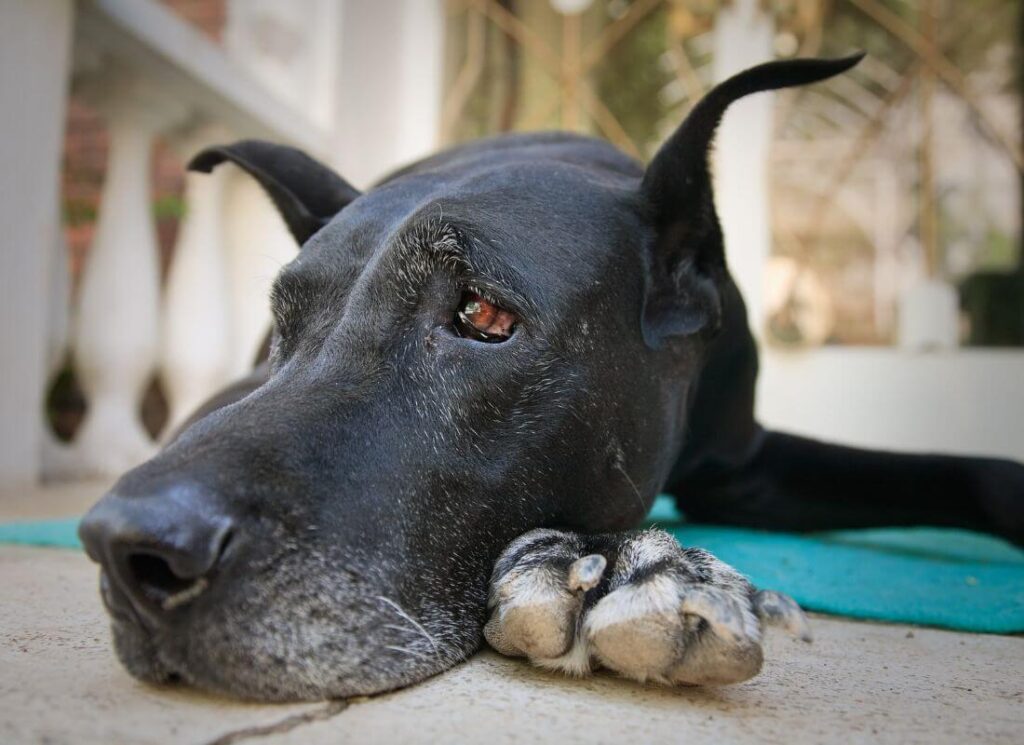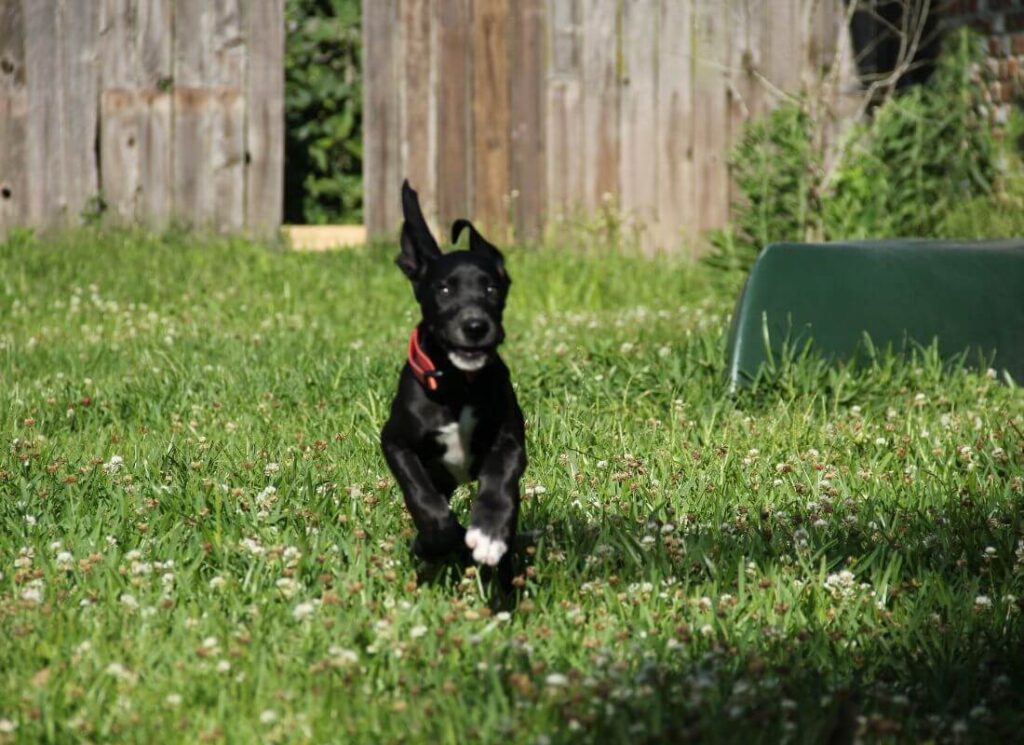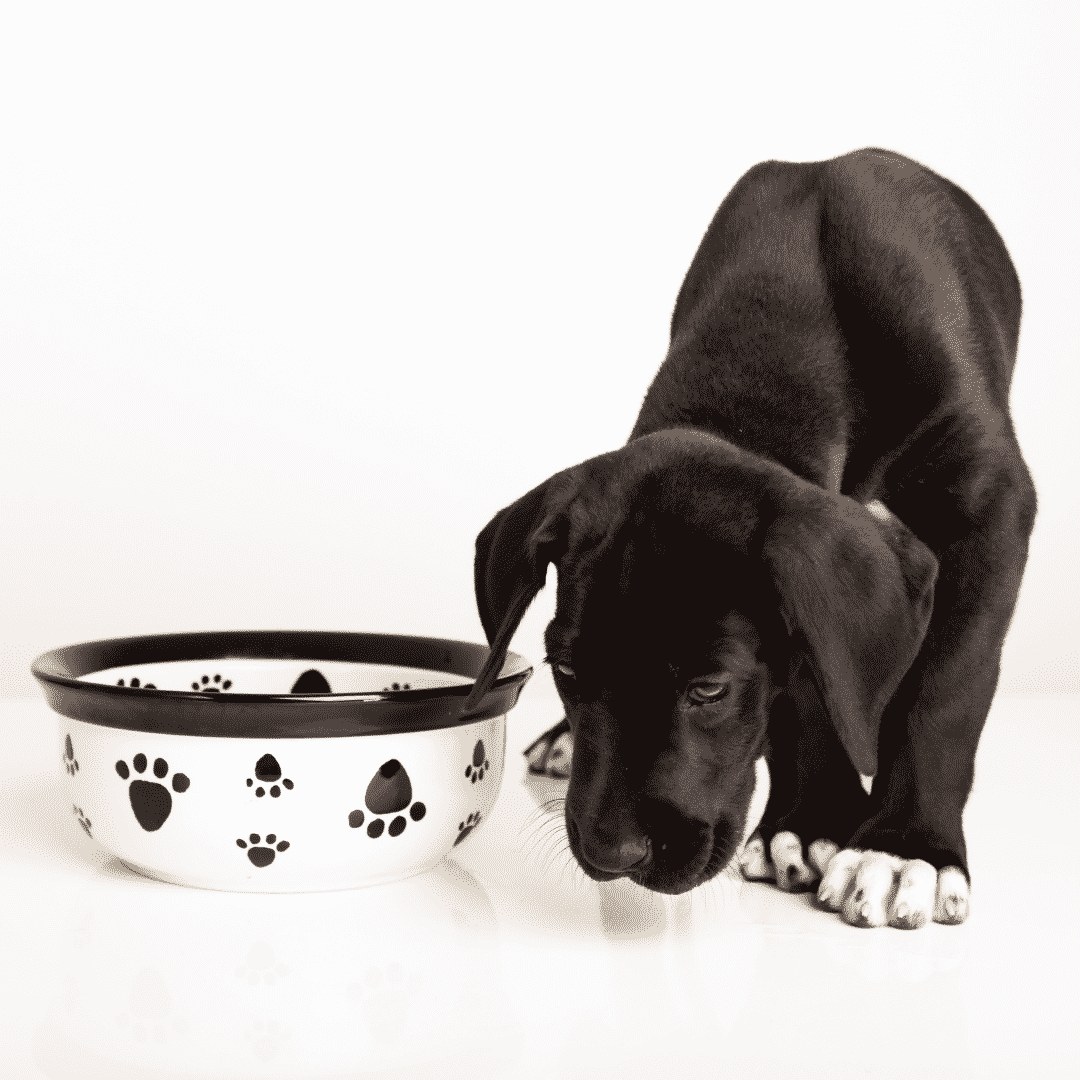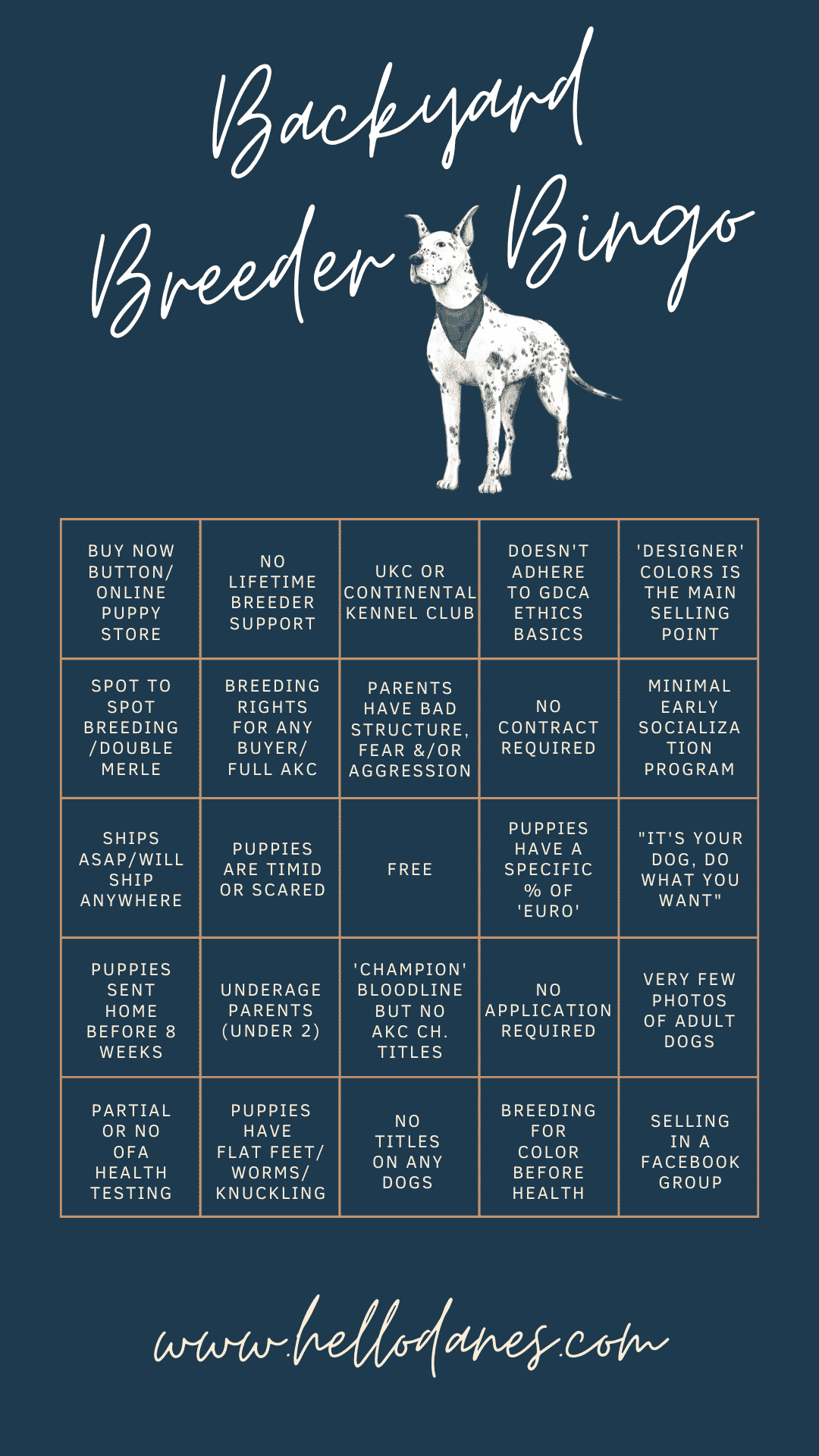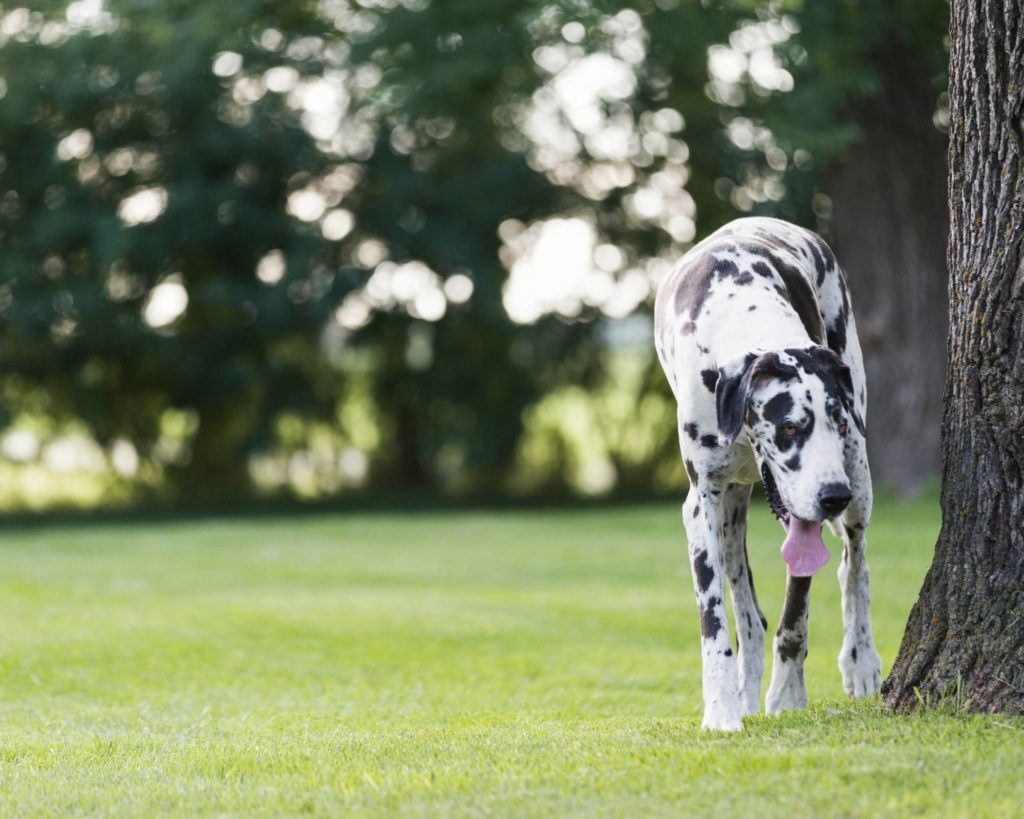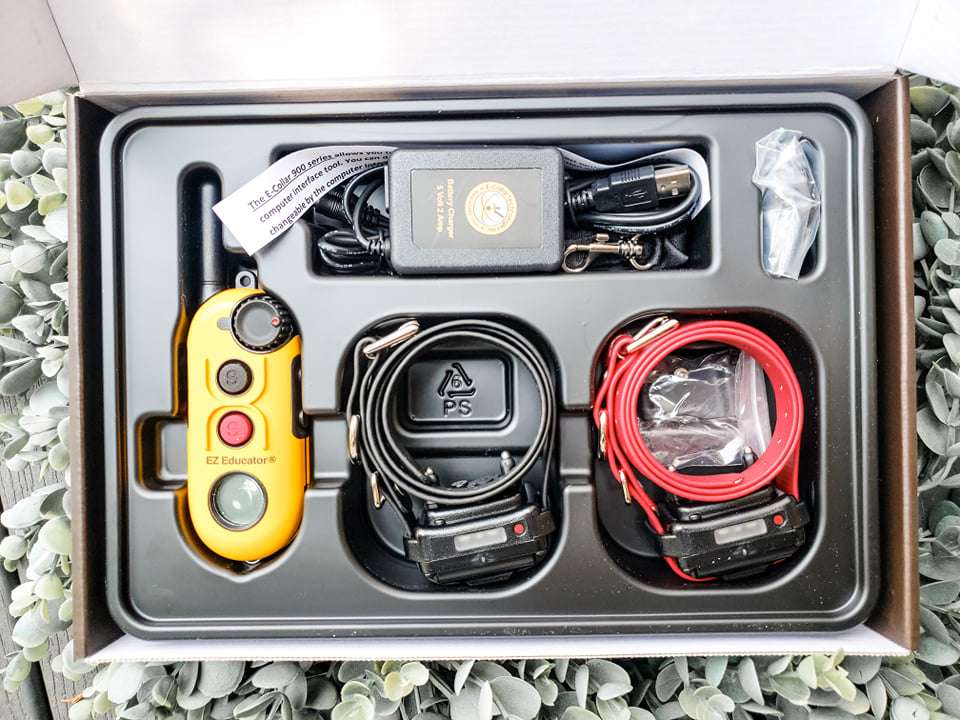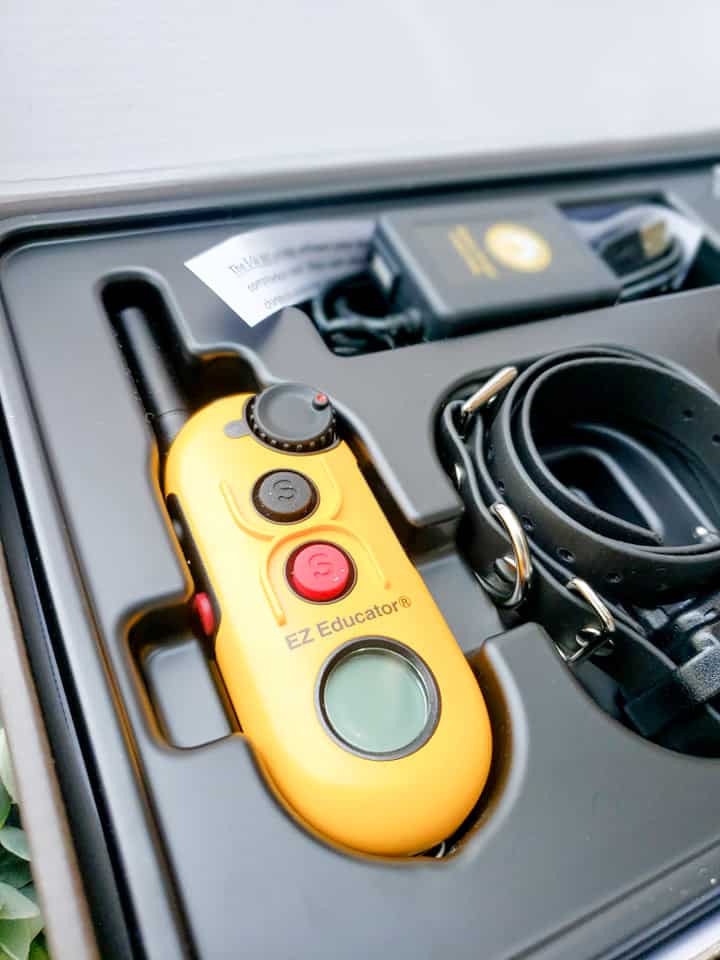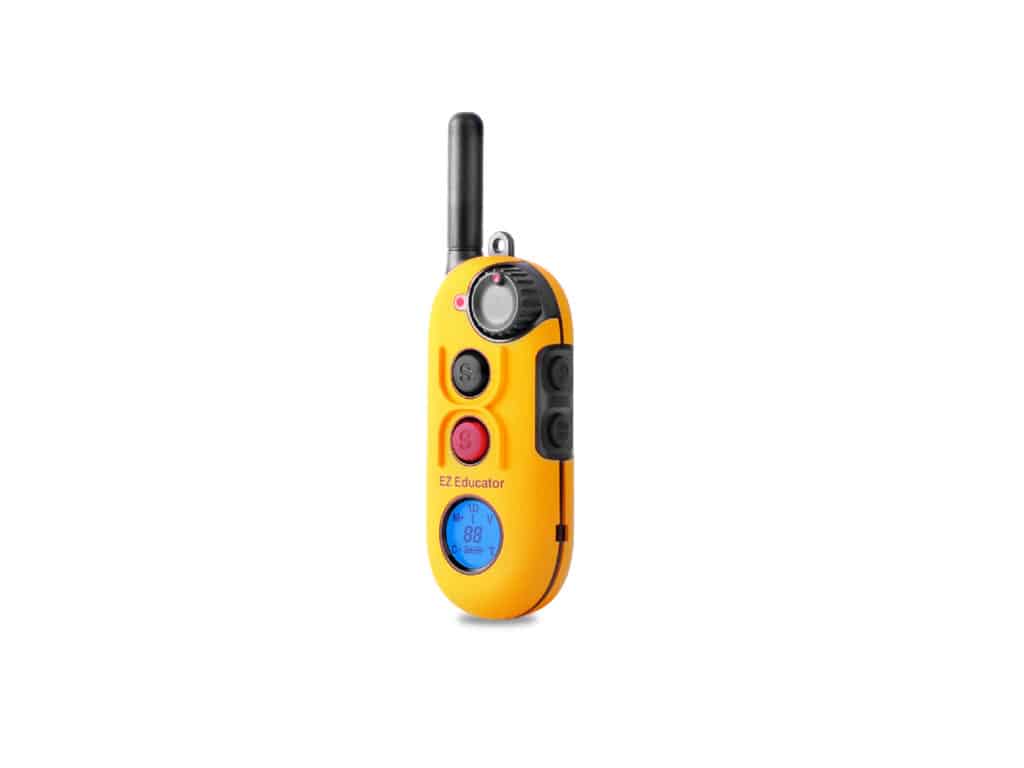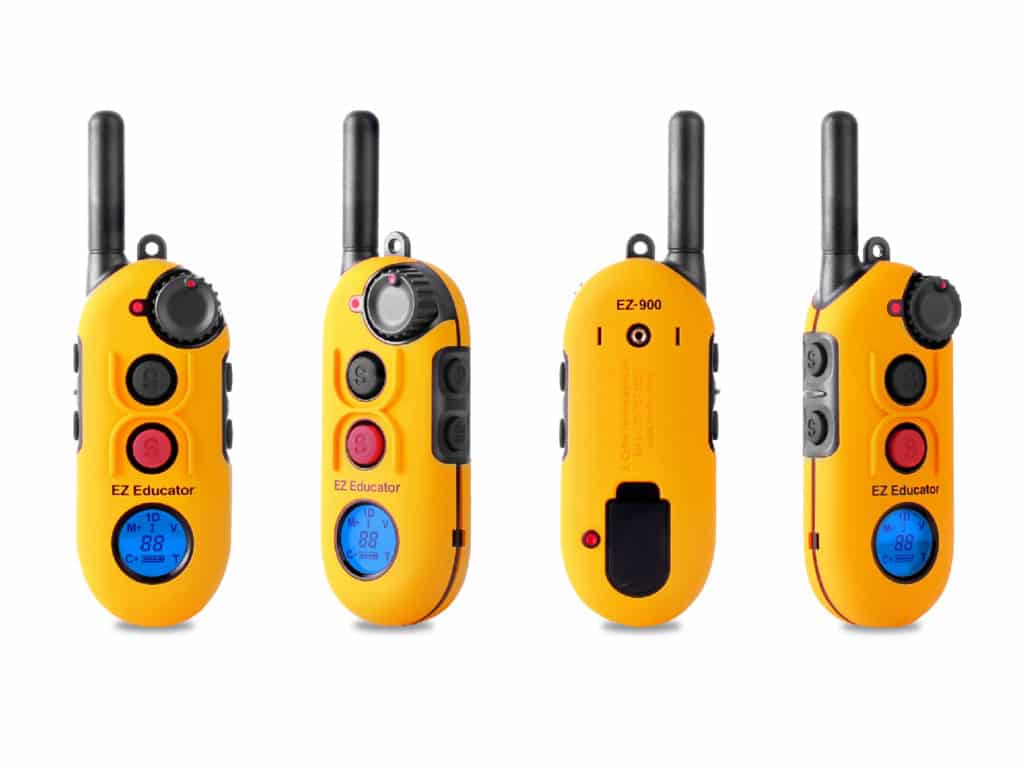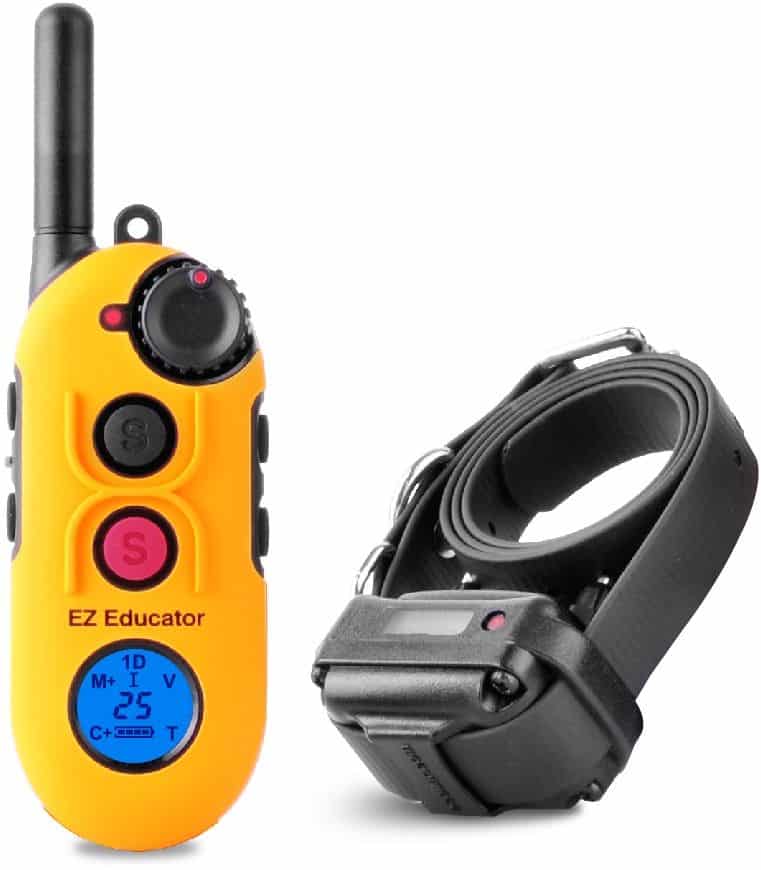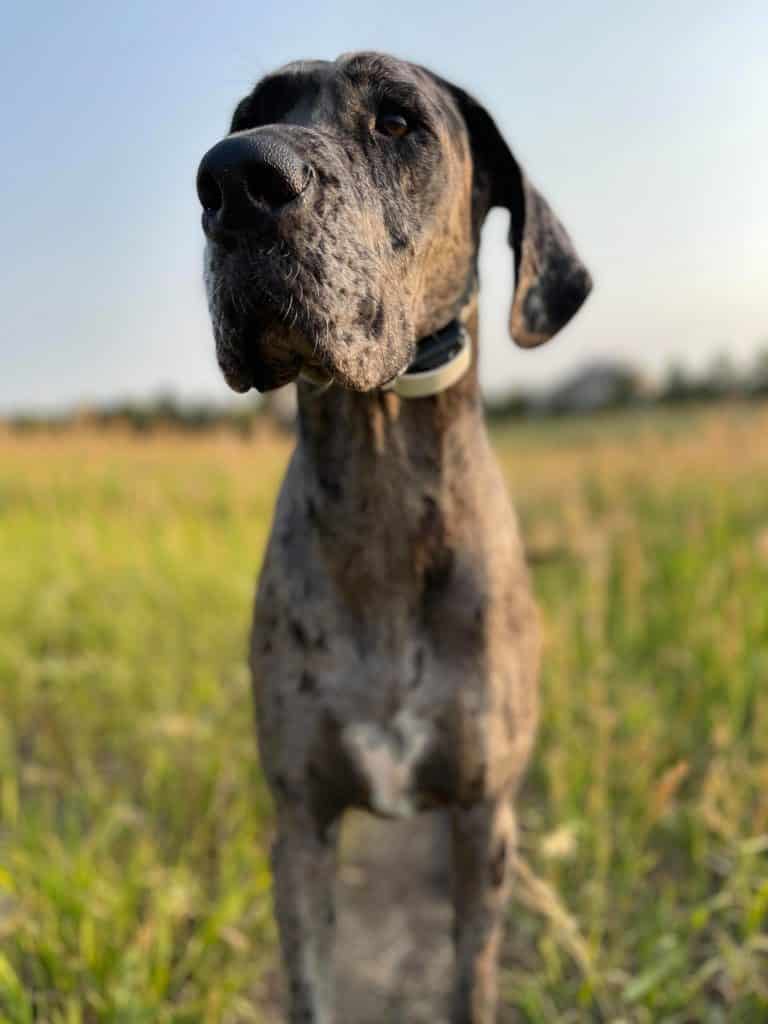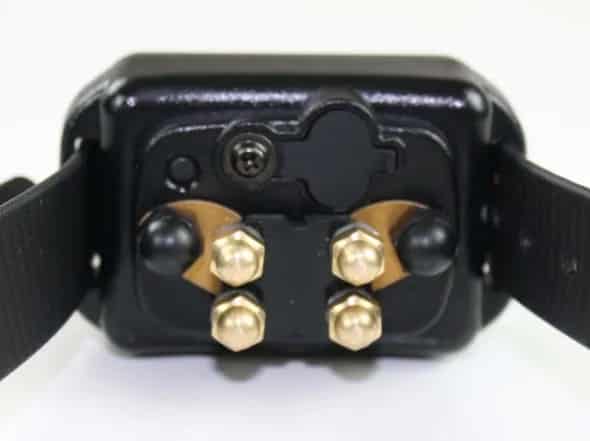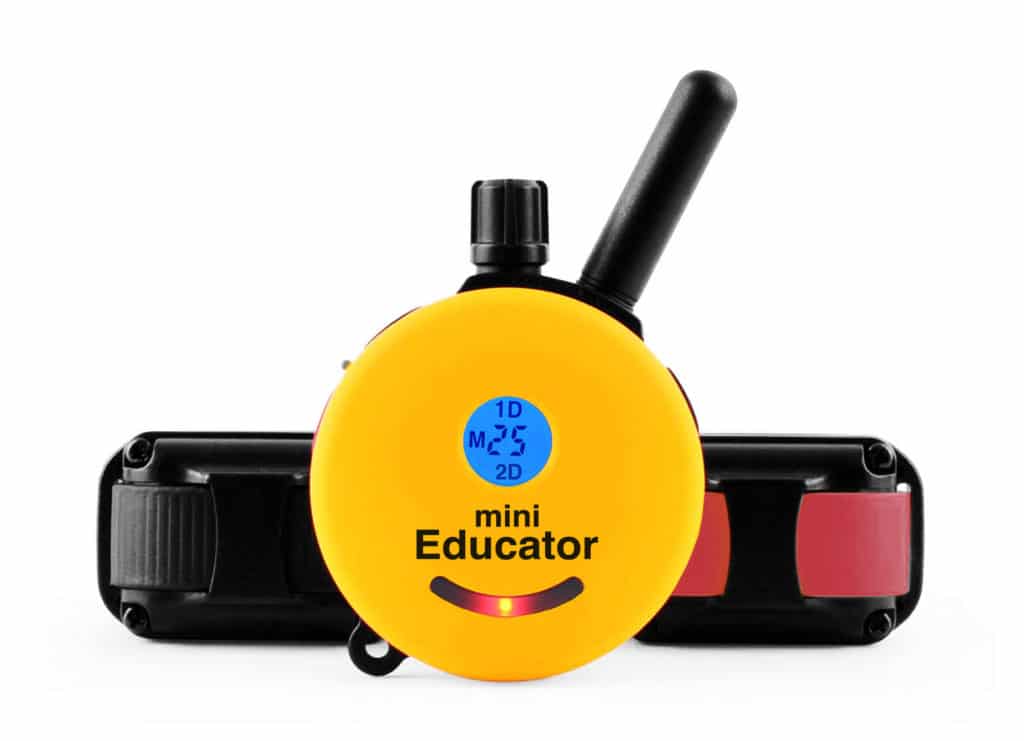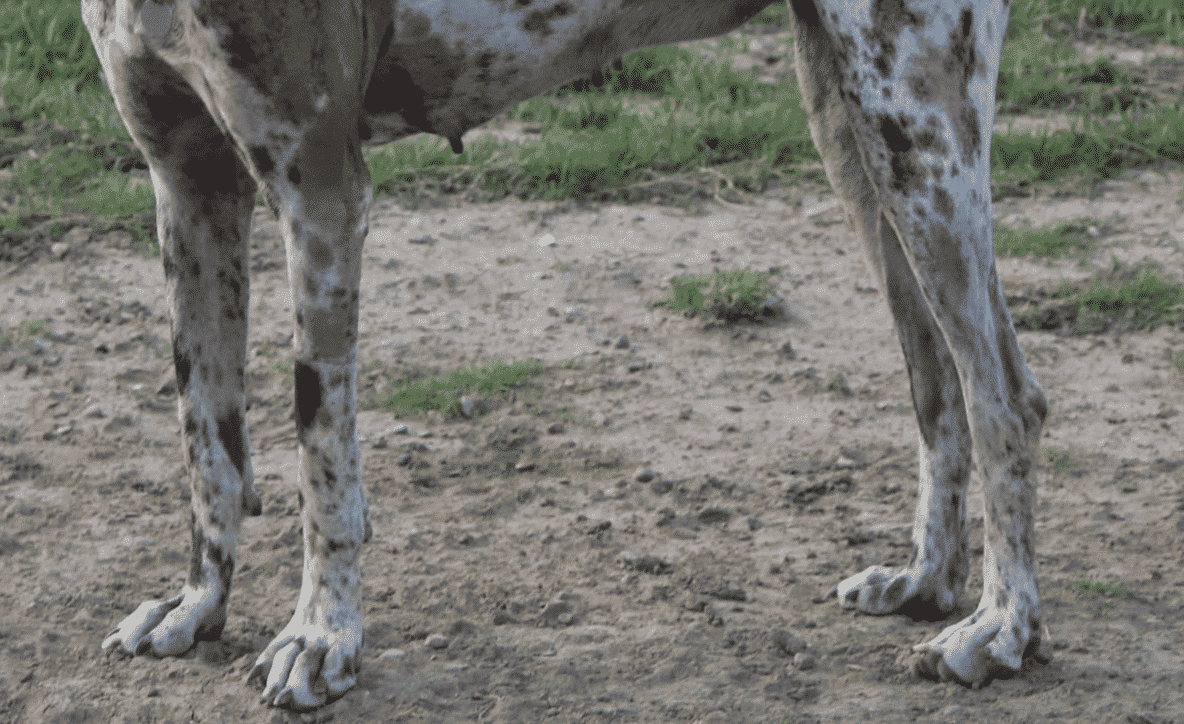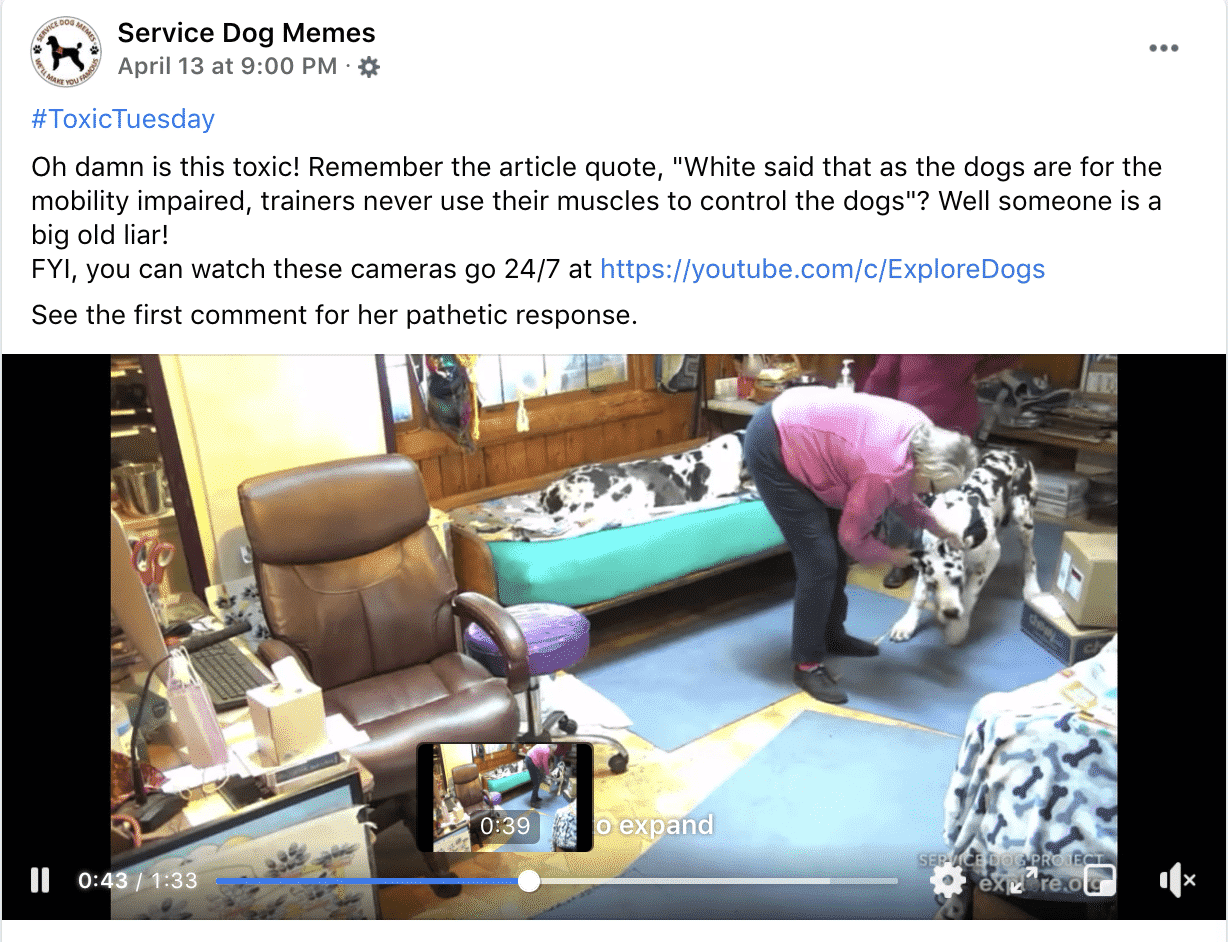Are you looking for the best e-collar for your Great Dane? Look no further! In this blog post, we will discuss:
- Some of the best e-collars on the market
- E-collar features
- How the modern e-collar is different from regular training collars
- Why they are perfect for Great Danes and other large breed dogs
- E-collar myths
- Tips for training Great Dane dogs
We will also provide information on how to choose the right e-collar for your dog and how to use it safely, humanely, and effectively.
Use our table of contents below to navigate (the headings are clickable!). This post is JAM PACKED with E-Collar information!
The Best E-Collars for Great Danes
5 Reasons to Choose E-Collar Training for your Giant Breed Dog
At Hello Danes we believe in modern, humane, positive E-Collar training. Here are 5 quick reasons to choose this for your pet!
- Unlike harnesses, collars, and leashes, the E-Collar uses absolutely no physical pressure or restraint.
This can be very important when you have a large, strong dog like the Great Dane! Not only that, but a Great Dane’s neck is very sensitive. We should not be relying heavily on any tools or leash attachment points that add ongoing physical pressure to the neck, chest, face, or back.
- E-Collar training is also very versatile.
You can use it for obedience training, recall, behavior modification, safety, boundaries, and more.
- E-Collars are also very safe, gentle, and humane when used properly.
We are providing you with tons of training tips in this post, or visit our famous Great Dane E-Collar training guide!
- Remote-collar trained dogs are a joy to take on hikes, walks, and trips to the dog park.
E-Collar training gives you the freedom to enjoy your dog without having to worry about them running off or getting into trouble.
- E-Collar training is a fun, positive experience for your dog!
If you’ve found our blog post today you may be wondering if choosing a shock or E-Collar for your Great Dane is even the right choice.
Chances are, you are feeling frustrated or overwhelmed by your Great Dane and some behavioral issues, including running off, jumping the fence, barking, and eating off the counter.
Or maybe you are hoping to improve recall and give your dog off-leash freedom.
Perhaps you heard that training tools like this (or prong collars) were abusive, aversive, punishing, and harmful to your dog. (Pro-tip, this is NOT true!)
We hear you, friend! You are in the right place. Read on for more information (or check out some of our popular links below).
6 E-Collar Training Myths BUSTED
5 GREAT Reasons to E-Collar Train Your Dog
Don’t Make These E-Collar Training Mistakes

How do E-Collars Work?
Modern E-Collars (the kind we recommend below) work by emitting a low level of stimulation to the dog’s neck.
The stimulation is similar to that of a medical-grade TENS unit. It does not zap or feel sharp, but rather feels like a tickle or muscle twitch.
This sensation completely replaces the physical pressure that your dog would otherwise feel from a leash, harness, or regular dog collar.
This virtual, wireless ‘pressure’ can be used in a number of ways to communicate with your dog from a distance.
As an added bonus, it cannot cause your dog ANY physical harm or orthopedic damage from pulling into a leash, harness, or dog collar. This truly is the most gentle and effective way to train your giant breed dog.

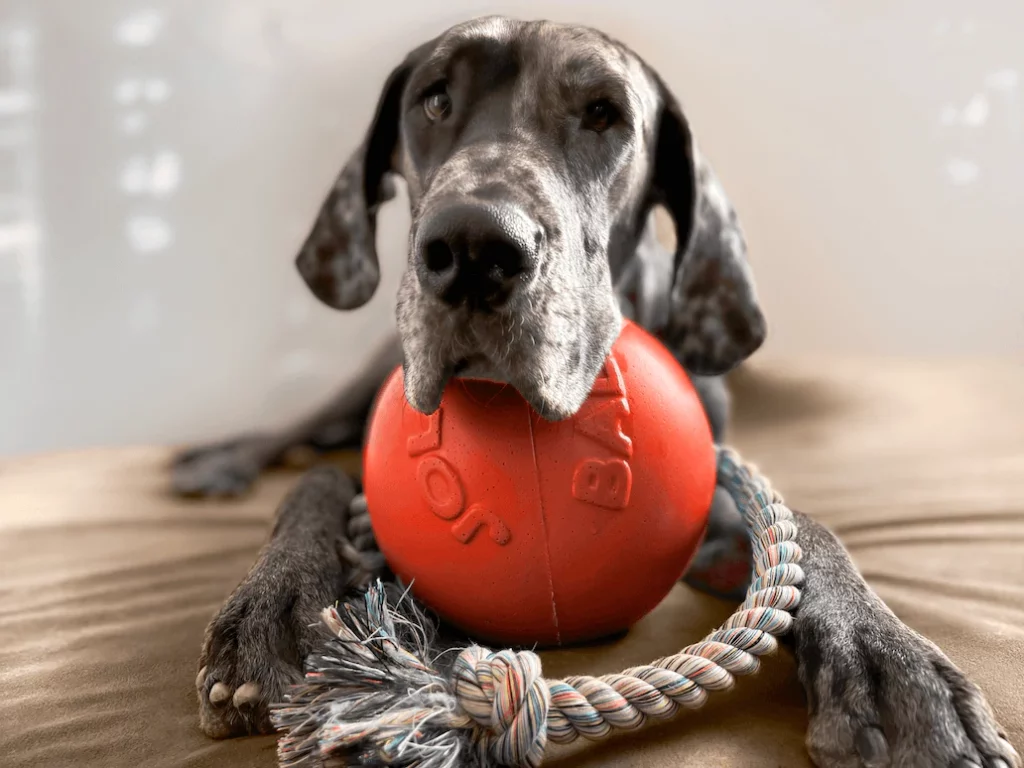

SHOCK COLLARS are different. These antiquated training tools rely on static to sharply ‘zap’ the dog, not unlike a cattle prod, hot wire fence, or sticking your wet finger in a plug socket.
The goal of a shock collar is to punish the dog for doing something wrong.
Shock is startling and often painful. These devices are cheap and easy to find on Amazon or even the local pet store
The cheaper the shock collar, the more likely it is to be unreliable (including shocking dogs at too high of a level or otherwise malfunctioning).
We do not recommend shock collars or old-style shock collar training for any reason.
Read on to learn about the more modern, effective, humane choice: E-Collars.
What is the difference between a Shock Collar and an E-Collar?
Gentle Leader vs. Prong Collar: The Great Debate
Our Review of the Gentle Leader Dog Collar
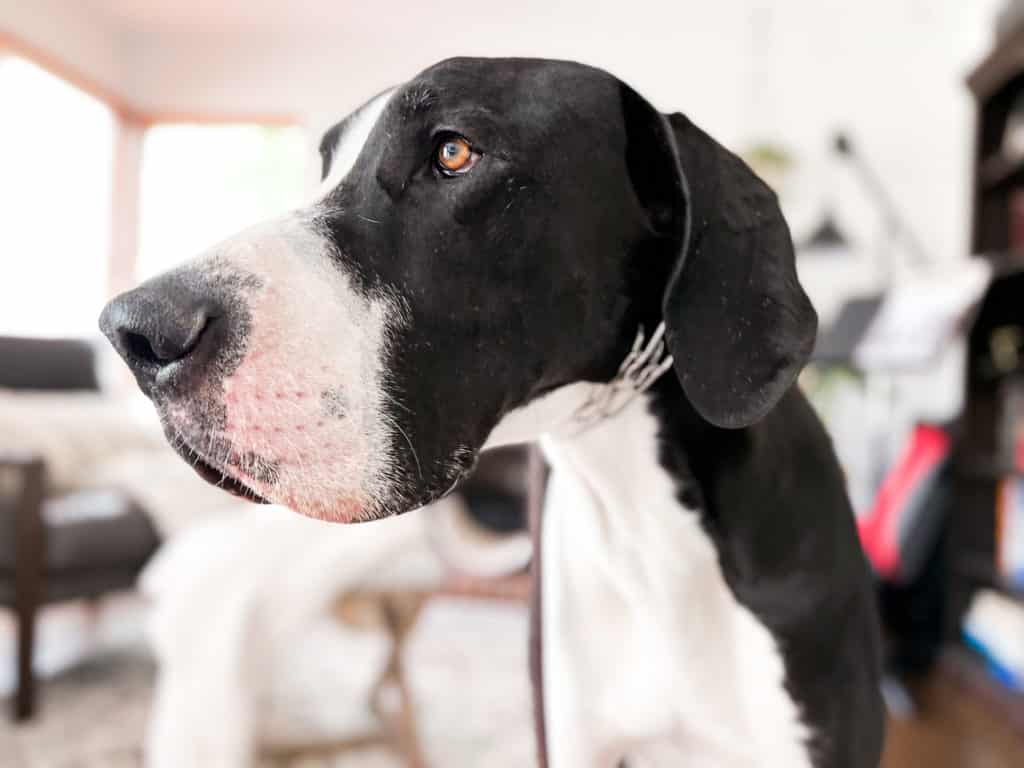
The Benefits of E-Collar Training Dogs
With some simple conditioning and training, a properly used E-Collar is a very positive tool that can help you:
- Teach your dog to have a reliable and enthusiastic recall (off-leash freedom, finally!)
- Have your dog calmly ignore dogs and people walking by
- Stop lunging and jumping
- Keep your dog safely behind an invisible boundary
- Stop fence jumping, once and for all
- Put an end to nuisance barking
- Stop counter surfing
- Redirect your dog away from rude social interactions
- Immediately recall your dog to you in an emergency
All without pain, fear or frustration.
We are here to be a resource for you when it comes to all things E-Collar, positive dog training, and more.
A well-trained Great Dane is happier, healthier and a joy to live with!
We do not recommend the purchase of any cheap shock collar for any reason. Cheap shock collars are made to punish, and E-Collars are made to communicate.
5 Great Reasons to E-Collar Train Your Dog
Things that are MORE Aversive than an E-Collar
Is ‘Positive’ Training Really Positive? How to Choose a Dog Trainer

The Best E-Collar Models for Giant Breed Dogs
We highly recommend E-Collar Technologies Educator series collars (ET-300, ET-400 and ET-900 models).
While we do offer them in our store ($10 off with code ECOLLARMAGIC), you can also buy them directly from the manufacturer. Amazon may have knockoffs or outdated models, so buyer beware.
We love these collars because they have pioneered modern off-lead dog training, and developed a proprietary tapping sensation that doesn’t hurt, punish, scare or harm your dog.
We will be covering each model’s features and pricing below so that you can choose the best training collar for your dog.

The Mini-Educator (300), the Educator (400) and the EZ Educator (900) models all offer adjustable stimulation levels from 1-100.
Most dogs will respond enthusiastically and work at levels 10-15 or less. The majority of humans can barely feel the stimulation, if at all, until level 8 or more!
Your dog will first be taught to have a positive association with this low-level sensation.
Our Top Pick for Beginners: the Mini-Educator
The Mini-Educator is our top pick for beginners because it is the most affordable option that still offers all of the features you need to get started with E-Collar training.
The Mini-Educator has a half-mile range and if you have two dogs, you can purchase a system with two collars!

The Mini-Educator remote collar is a simple, easy-to-use, and rugged system.
The receiver and remote are impact-resistant and waterproof, and features include adjustable stimulation, vibration sensation, tone, and night light.
We recommend the Mini-Educator for Great Dane owners that need a 1/2 mile or less range and want an easy-to-use choice without bonus frills.
From a tactile standpoint, the round shape of the remote is not only fun and unique but feels great in the hand!
Different skins can be purchased to change the color.
Included with your Mini-Educator remote training system:
Remote
Receiver
Biothane dog collar with metal buckles
Lanyard
Two sizes of contact points
Contact point changing tool
Charging cable
Manual
We are an authorized dealer of Educator collars. When you purchase from us, you’ll be receiving the latest model direct from their warehouse.
We also provide email training support and training support in our online community!
Our Top Pick for Long-Distance Dogs: The Educator Collar
The Educator remote collar looks almost identical to the Mini-Educator but offers a bigger range (3/4 mile) than the Mini-Educator listed above.
The receiver and remote are rugged and waterproof, and features include adjustable stimulation, vibration sensation, tone, and night light.
The Educator is also available in a one or two-dog system if you have multiple dogs!
We recommend the Educator for Great Dane owners that need more range than the Mini-Educator (ET-300) series can offer but still prefer simplicity and ergonomics.
Choose the one or two-dog system below, and get started!
Our top pick for multiple dog homes: The EZ-Educator

The EZ Educator remote collar offers a 1/2 mile range and endless customization options.
The receiver and remote are rugged and waterproof. Features include adjustable stimulation, adjustable vibration sensation, adjustable tone, and more!
The EZ Educator is available in a one, two, three or four dog system and is often the tool of choice for professional dog trainers.
We recommend the EZ Educator for Great Dane owners that love technology and like having a lot of choices in their hands.
The EZ Educator system can be used with up to four dogs (one remote controls each dog independently) and is endlessly customizable.
Remember, no two dogs are the same, and this tool addresses that beautifully.
Read our IN-DEPTH review of the ET-900 model HERE →
+ 1/2 Mile Range
+ One or Two Dog System
+ Stim levels 1-100
+ Stim Boost
+ Tapping Sensation
+ Tone
+ Night tracking light
+ Compact, ergonomic remote
+ 2-Hour Charge
+ Waterproof & Impact Resistant
We are an authorized E-Collar Technologies dealer and chose to work with this brand, not the others because it’s the one we believe in the most!
They have the best customer service and the most reliable E-Collars we’ve worked with.
When you order from Hello Danes, you are backed by Great Dane lovers and will receive the latest model collar directly from the manufacturer.
We are here to support you with all of your Great Dane, positive training, and E-Collar questions!

E-Collar Training Information & FAQ
Imagine reliably training your Great Dane using communication that you may barely be able to feel yourself.
Contrary to popular belief, you do NOT need to shock or scare your dog into obedience.
The E-Collar is a powerful tool that when used correctly, provides much more outstanding results than traditional shock collar training! EVEN with large, in-charge, and currently out-of-control dogs.
Of course, because the E-Collar is adjustable (100 different levels!) you can find the magic place where your dog responds. Then, you can easily utilize a stronger stimulation or the more aversive vibration sensation for the times when the dog is distracted or needs immediate redirection for safety reasons.
From Running Away to Off-Leash
E-Collar tips that you must know!
- E-Collar training begins with teaching the dog to associate the stim feeling with positive things such as treats, praise, fun and attention. Not punishment!
- Proper E-Collar training relies heavily on positive reinforcement. You can teach a dog MUCH faster if you first teach and reward them for the behavior that you want, and then use the E-Collar to clarify the communication.
- Unlike zap and startle shock collar training, your dog will be an active participant in training.
Can I punish my dog with an E-Collar?
There is a time and a place for using higher levels as a means to communicate “NO” to your dog.
However, when used correctly, this is a tiny piece of proper E-Collar training (if used at all).
Having a dog ‘cower and run’ when you ‘show them the remote’ is not a positive thing.
With E-Collar training, the remote is never a threat, and scaring your dog into obedience isn’t the goal.
Can I use an E-Collar on a Great Dane puppy?
We recommend starting Great Dane collar training only once your dog (or puppy) has a solid basic obedience foundation.
Your dog should know how to sit, down, come and ‘place’ (or stay) at a basic level, and they should enjoy learning with you!
Once that foundation is in place, you can start your E-Collar conditioning at any time (usually around 4-6 months of age).
Great Dane puppies are incredibly smart and loyal! By implementing modern, gentle training you’ll soon have an incredible gentle giant that can be off-leash with you, anywhere you go.
Do big dogs need more powerful collars?
This myth is brought to you by people with no credible background in canine education!
Large dogs are just as responsive and sensitive to gentle e-collar stimulation as small dogs are.
The best collars for large breed dogs and our gentle giants are also the most gentle! The modern e-collar works incredibly well without harsh corrections.
What about bark collars?
We recommend the use of the Sport Dog bark collar ONLY after you have addressed all of the root reasons behind barking: boredom, anxiety, frustration, aggression, and habit. You can read our Great Dane barking article HERE.
By choosing a different brand for bark corrections, your dog will have a different association with the collar. When your dog barks, the SportDog bark collar will issue a correction. Never use cheap bark collars as they can make dogs suspicious, cautious and nervous.

How to Teach Recall with an E-Collar
- First, the dog is conditioned to view the stim sensation, at a low level, as a positive thing. Stim = treats and praise, YAY! If you do this correctly, the dog will feel the stim and get really excited about it.
- Second, the dog is taught, using positive reinforcement what the word ‘COME’ means. Starting at a short distance with no distractions, the dog quickly learns without error or correction that COME = good things such as praise, games, and treats.
- Third, the dog learns that STIM + COME together = come back, starting at a short distance. Because both STIM and COME = good things, the dog responds.
- With just a few short weeks of practice, you can then utilize stim and positive reinforcement to your advantage at increasing distances and around more distractions such as people, dogs, cars and children.
- As the dog returns, you can use the dial to gradually reduce the stim sensation, similar to a game of hot and cold…only in this case, ‘cold’ is the goal! .
- The dog quickly learns that staying close and coming back = being able to turn the stim sensation both down and eventually off, which is VERY rewarding to the dog.
Remember, with E-Collar training your dog is an ACTIVE participant in the training, and that’s why it works!
E-Collar Myths
Here are some common myths about E-Collar training.
E-Collar training is NOT cruel. The E-Collar is a tool, and like any tool, it can be used correctly or incorrectly.
The goal of E-Collar training is to establish clear communication with your dog in order to have a better relationship and give your dog MORE freedom!
Read on for more common misconceptions about our favorite dog training tool!
Myth: E-Collars just shock the crap out of dogs
Many people believe that the only reason a dog is responsive to their training collar is that you are ‘shocking the crap out of them’ until they come back.
This couldn’t be farther from the truth.
When your cell phone rings, you answer it. It doesn’t hurt you, scare you, punish you, or make you aggressive but it is mildly annoying.
The gentle sensation from the dog collar works the same way. It doesn’t hurt your dog, and just like your cell phone, your dog knows how to turn it off!
All they have to do is come running towards you.
Myth: Your dog is only trained because you forced them
Some people promote the misguided idea that an electric training collar only works because the dog is being punished and forced.
Remember, the stimulation simply replaces pressure from a harness, prong collar, flat collar, or any other type of dog collar.
If we’re going to talk about force, let’s talk about that. Physical restraint is a form of force that is completely removed when you choose off-leash training.
Your dog will be free to move naturally without restrictions, and all they have to do is be responsive to boundaries that you communicate to them using a gentle tactile sensation.
A Great Dane wearing an e-collar is a large dog that is being kept safe, without frustration, pain, or punishment.
As a matter of fact, I’m writing this as we speak with my completely off-leash, intact male Great Dane sitting by my side.
We are on my front porch, in an unfenced yard, with dogs and people walking by. He is calm, happy, and loving life!
Myth: A long leash is more humane
Because people incorrectly believe that all training collars are being used to punish and harm dogs, they will also promote the idea that a long leash is a humane alternative.
While a long leash is necessary during training, it should not be considered the more ‘humane’ choice.
Long leashes can be exceptionally dangerous! If your dog is at the end of a 20-foot lead, you have very little control.
A dog can become tangled or wrapped up by a leash, and excessive force and pressure may be placed on the neck, chest, and shoulders as a result.
Additionally, it is unsafe for dogs to greet each other while on a leash.
Zooming, making circles, running with abandon, zipping through the ocean waves, swimming, climbing up onto or under things, and having a healthy play session with another dog are activities that are unsafe while on any kind of leash (including a long line).
Ditching the leash and using a modern E-Collar instead is the most humane, safe, and effective choice! It is unfair to keep dogs on a leash for their entire life when there is a modern, fantastic alternative!
Myth: Your dog will become aggressive if you use a training collar!
This misguided belief is based on incorrect use. Aggression, frustration, fear, and anxiety can be caused by all forms of training, including positive reinforcement and force-free training!
As a matter of fact, some of the most reactive and frustrated dogs we know were trained using ‘force-free’ methods. It is unfair to place blanket blame on this tool.
If you are turning the stimulation up to aversive levels and intentionally doing so to hurt, scare and punish your dog on a regular basis, without conditioning them to the collar first, then yes.
You can cause aggression.
But used correctly? Nope.
Chances are, you’ll find that your dog is actually calmer, happier, and LESS reactive. Being off-leash is so much more enriching and freeing to dogs than spending life isolated from experiences or trapped by physical restraint devices.
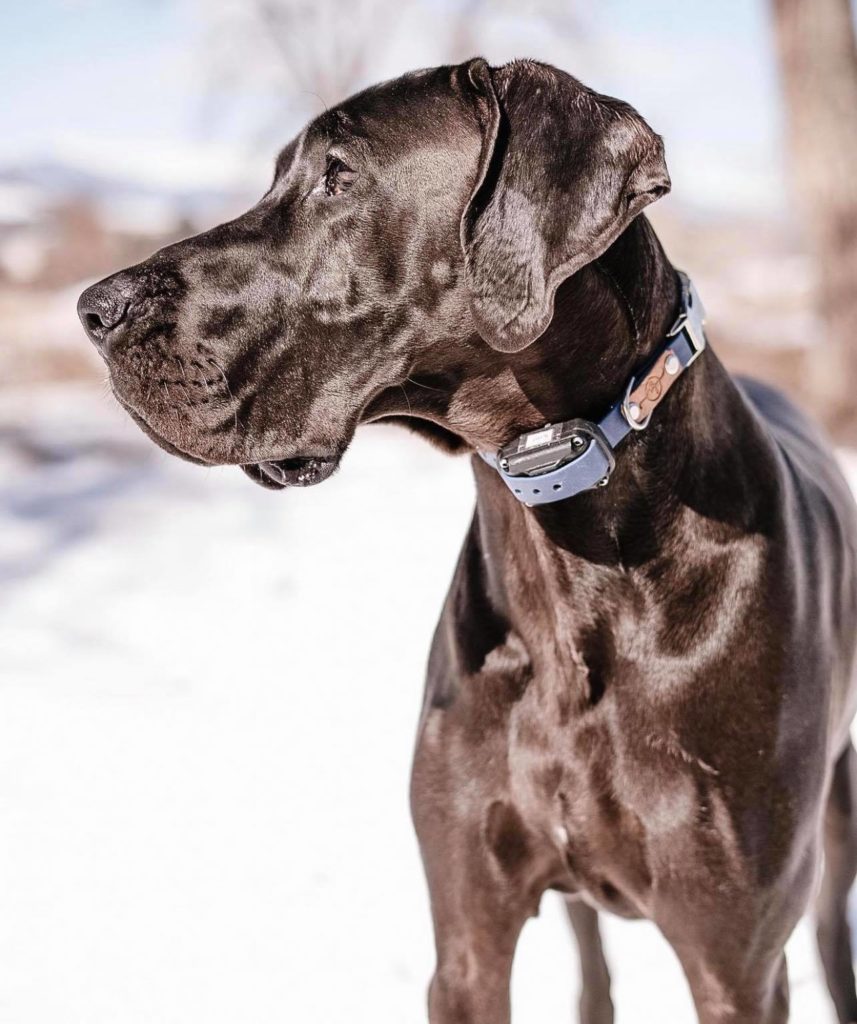
Great Dane TrainingTips & Tricks
- Never leave your great dane in their e-collar unattended
- Rotate the collar often, and make sure that you have chosen the correct fit for your dog’s neck size. The collar should fit snug and not rub.
- Consider investing in contact points made of different metals if your dog has sensitive skin
- Use lots of positive reinforcement, and build a solid foundation before getting started!
- Check out our famous E-Collar Training for Great Danes guide, which walks you step by step through the process from untrained to off-leash in just weeks.
Where to Buy E-Collars for a Great Dane
Visit our E-Collar shop, and feel free to reach out and ask questions!
We ONLY recommend and sell what we use on our own beloved dogs.
All of the products in our shop have been personally tested by us, and we are happy to answer any questions that you may have! We ship dog training collars directly from the manufacturer’s warehouse, so you are sure to get the latest model.
Not to mention, we are here for you with email support, or join our group and ask questions.
We regularly take 5 happy Great Danes off-leash, thanks to E-Collars and positive reinforcement training. Need more motivation?
Use THIS COUPON for $10 off your purchase of Educator Collars from our online shop: ECOLLARMAGIC
Shop E-Collars below!

